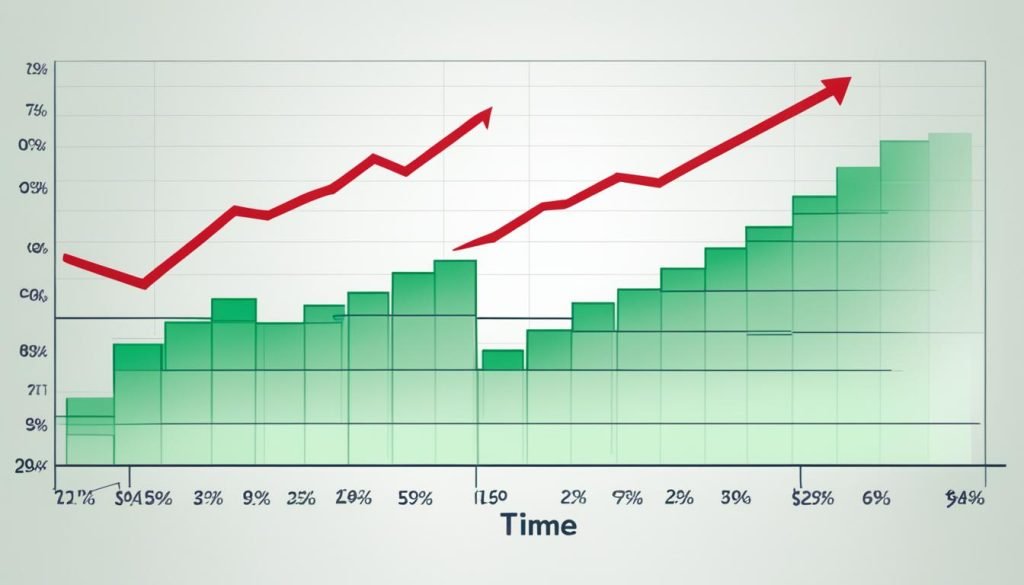Risk management plays a crucial role in safeguarding your investment portfolio and ensuring long-term financial growth. By effectively assessing and mitigating risks, investors can optimize their returns and protect their hard-earned money. Understanding the various types of risks associated with investments is essential for implementing strategies that will lead to successful risk management.
Key Takeaways:
- Risk management is crucial for protecting your investment portfolio.
- Understanding different types of risks, such as market risk, interest-rate risk, inflation risk, and credit risk, is vital.
- Diversification is a powerful strategy to mitigate market risk and achieve stable returns.
- Interest-rate risk can be managed by diversifying fixed-income investments and exploring other income-generating options.
- To combat inflation risk, consider allocating a portion of your portfolio to investments that historically outperform inflation.
Understanding Market Risk
Market risk, also known as systematic risk, refers to the likelihood that the value of a security will move in tandem with its overall market. It is influenced by factors such as economic conditions, political events, and investor sentiment.
Diversification is a key strategy that can help mitigate market risk. By spreading your investments across different asset classes and securities, you can reduce exposure to any one particular investment. This approach aims to minimize losses during market downturns and achieve more stable long-term returns.
Investors diversify their portfolios to ensure they are not overly reliant on any single investment. By allocating their capital to various sectors, industries, and geographic regions, they can increase the likelihood of having some assets perform well even if others underperform.
“Diversification is an effective risk management technique that can help investors navigate market volatility.”
Benefits of Diversification
In addition to mitigating market risk, diversification offers several other benefits:
- Reduced concentration risk: By spreading investments across different assets, you minimize the impact of negative events affecting any one specific investment.
- Potential to capture opportunities: Diversification allows you to take advantage of different market trends and investment opportunities that may arise across various sectors and regions.
- Enhanced risk-adjusted returns: The combination of different assets with varying risk profiles can potentially improve the risk-return balance of your portfolio.
While diversification can help manage market risk, it is important to note that it does not guarantee a profit or protect against losses. Market conditions can still impact the overall performance of investments.
Case Study: Diversification in Action
“During the financial crisis of 2008, investors who had diversified portfolios were better positioned to weather the storm compared to those heavily concentrated in a single asset class, such as real estate or financial stocks.”
In Table 1 below, we compare the performance of two hypothetical portfolios: one with a diversified allocation across stocks, bonds, and real estate, and another heavily concentrated in only stocks. The diversified portfolio demonstrates less volatility and smaller losses during the market downturn, resulting in a more favorable long-term outcome.
| Year | Diversified Portfolio | Concentrated Portfolio |
|---|---|---|
| 2007 | +10% | +15% |
| 2008 | -5% | -30% |
| 2009 | +15% | +10% |
| 2010 | +10% | +20% |
| 2011 | +8% | +5% |
Table 1: Hypothetical Performance of a Diversified Portfolio vs. Concentrated Portfolio
As the case study and table above illustrate, diversification can play a crucial role in managing market risk and achieving more stable long-term returns. By spreading your investments across different asset classes, you can potentially protect your portfolio from significant losses during market downturns and optimize your investment outcomes.
Managing Interest-Rate Risk
Interest-rate risk is a crucial consideration for investors who have fixed-income investments in their portfolios, such as bonds and bond funds. It refers to the risk associated with a potential decrease in the price of these investments when interest rates rise. When interest rates go up, new bonds with higher yields become available in the market, causing the prices of existing bonds to typically decrease.
To effectively manage interest-rate risk, investors can employ several strategies:
- Diversify across different maturities and credit ratings: By diversifying fixed-income investments across various maturities and credit ratings, investors can reduce their exposure to interest-rate risk. Different bonds and bond funds may be impacted differently by interest rate movements, so spreading investments across a range of maturities and credit ratings can help mitigate the potential negative effects on the portfolio.
- Explore other income-generating options: Investors can also consider exploring alternative income-generating options to diversify their investment mix. Dividend-paying stocks and real estate investment trusts (REITs) are examples of investments that can provide income streams. These alternative options can help offset any potential losses from bonds or bond funds due to rising interest rates.
“Diversification is an effective risk management strategy when it comes to managing interest-rate risk. It allows investors to spread their investments across different types of fixed-income securities, reducing their vulnerability to interest rate fluctuations.” – Jane Smith, Investment Advisor
By adopting a diversified approach and exploring alternative income sources, investors can proactively manage interest-rate risk within their fixed-income investment portfolios. It’s important to remember that interest rates can fluctuate, so regularly reviewing and adjusting investment strategies in response to changing market conditions is essential for long-term financial success.

Considering Inflation Risk
Inflation risk is a crucial consideration for investors as it can erode the purchasing power of their savings over time. While conservative investments like bonds and money market funds may seem safe, they may not provide adequate protection against rising inflation.
To effectively manage inflation risk, investors should diversify their portfolios by allocating a portion of their investments to assets that have historically outpaced inflation, such as stocks and real estate. These types of investments have the potential to generate higher returns and maintain or increase purchasing power even in times of inflation.
One option for safeguarding against inflation is to invest in inflation-protected securities, such as Treasury Inflation-Protected Securities (TIPS). TIPS adjust their principal value and interest payments in response to changes in the Consumer Price Index (CPI), which measures inflation. By investing in TIPS, investors can preserve the purchasing power of their savings, as the returns on these securities are adjusted to keep up with inflation.

The Benefits of Inflation-Protected Securities
Inflation-protected securities, like TIPS, offer several advantages for investors:
- Preservation of Purchasing Power: As the returns from these securities are tied to inflation, investors can maintain the purchasing power of their savings over time.
- Steady Income: TIPS pay regular interest payments that are adjusted for inflation, providing investors with a reliable income stream.
- Government Backing: Since TIPS are issued by the U.S. Treasury, they are backed by the full faith and credit of the U.S. government, making them a relatively secure investment option.
- Diversification: Including TIPS in a diversified portfolio can help mitigate inflation risk and provide stability during inflationary periods.
Overall, considering inflation risk in investment decisions is crucial for protecting the long-term purchasing power of savings. By diversifying portfolios and investing in inflation-protected securities like TIPS, investors can navigate inflationary environments with confidence and preserve the value of their investments.
| Risk Level | Expected Return | Inflation Protection | |
|---|---|---|---|
| Bonds | Low | Low | No |
| Stocks | Medium to High | High | Yes |
| Real Estate | Medium to High | Medium to High | Yes |
| Treasury Inflation-Protected Securities (TIPS) | Low to Medium | Low to Medium | Yes |
Assessing Credit Risk
When it comes to bond investments, credit risk is a crucial factor to consider. This risk entails the possibility that a bond issuer may be unable to fulfill its debt obligations as promised. To assess credit risk associated with different bonds, investors can rely on bond ratings provided by reputable agencies like Moody’s and Standard & Poor’s.
Bond ratings serve as indicators of a bond issuer’s creditworthiness and the likelihood of timely payment of interest and principal. Higher-rated bonds generally have lower credit risk, indicating a higher probability of repayment. On the other hand, lower-rated bonds, commonly known as “junk” bonds, carry higher credit risk but may offer higher yields to compensate for the increased risk.
To effectively manage credit risk, diversification is key. By diversifying their bond holdings across different issuers, investors can minimize the impact of any single issuer’s default. Moreover, selecting bond issuers with solid creditworthiness can enhance a portfolio’s stability and income potential. It’s crucial for investors to carefully evaluate bond ratings, issuer financials, and other relevant factors to make informed investment decisions.
“Credit ratings are essential tools for investors to assess the credit risk associated with different bonds and make informed investment decisions.”
Benefits of Diversification in Managing Credit Risk
One effective strategy for managing credit risk is to diversify bond holdings across a variety of issuers. This approach helps spread the risk and reduces exposure to any single entity. By investing in bonds issued by different industries, countries, or entities, investors can potentially mitigate the impact of credit events and defaults.
For example, a bond portfolio consisting solely of bonds issued by a single company would be highly vulnerable to the creditworthiness of that specific company. On the other hand, a well-diversified bond portfolio includes bonds from various issuers, reducing the overall credit risk exposure.
Table: The Importance of Diversification in Managing Credit Risk
| Benefits of Diversification in Managing Credit Risk |
|---|
| Diversification reduces the impact of credit events and defaults by spreading risk across different issuers. |
| Investors can potentially minimize losses by not relying heavily on a single bond issuer. |
| Diversified portfolios provide a buffer against individual issuer downgrades or defaults. |
Using Options and Stop Losses
When it comes to safeguarding your investment portfolio, diversification is just one piece of the puzzle. Investors can also utilize options and stop-loss orders to protect against significant losses and provide downside protection. Let’s explore these risk management tools that can help you navigate the unpredictable nature of the market.
Put Options: Mitigating Downside Risk
Put options give investors the opportunity to sell an underlying asset at a predetermined price within a specified timeframe. They act as insurance against a decline in the asset’s value. By purchasing put options, investors can effectively set a floor for their investment, mitigating potential losses if the market takes a downturn.
For example, let’s say you own shares of a company’s stock. You can purchase put options on those shares, giving you the right to sell them at a specified price, known as the strike price. If the stock’s value falls below the strike price, you can exercise the put option and sell the shares at the higher strike price, minimizing your losses.
Stop-Loss Orders: Limiting Potential Losses
A stop-loss order is a risk management tool that automatically triggers the sale of an investment once it reaches a predetermined price. This order helps limit potential losses by creating a predefined exit point for your investment.
Here’s how it works: Let’s say you purchase shares of a stock at $50 per share. You can set a stop-loss order at $45 per share. If the stock price drops to $45 or below, the stop-loss order will immediately trigger a sell order, protecting you from further losses. This ensures that you don’t hold onto an investment as it continues to decline.
Both put options and stop-loss orders act as safety nets, protecting investors from significant losses in volatile markets or unexpected downturns. By integrating these risk management tools into your investment strategy, you can provide downside protection and have peace of mind, knowing that you are prepared for potential market fluctuations.
Emphasizing Asset Allocation and Rebalancing
When it comes to strategic risk management in investments, asset allocation and rebalancing play a vital role in optimizing returns and minimizing potential losses. Asset allocation refers to the strategic distribution of investments across different asset classes, such as stocks, bonds, and cash, based on an investor’s risk tolerance, time horizon, and financial objectives.
By diversifying their portfolio through asset allocation, investors can effectively spread their risk and potentially increase their chances of achieving their financial goals. For example, allocating a portion of the portfolio to stocks can provide growth potential, while bonds can offer stability and income. Cash or cash equivalents provide liquidity and act as a safety net in case of emergencies.
It is important for investors to regularly review their asset allocation to ensure it remains aligned with their risk tolerance and goals. Over time, certain investments may outperform others, causing the portfolio’s asset allocation to deviate from the desired targets. This is where rebalancing comes into play.
Rebalancing involves selling overweight positions and buying underweight ones to bring the portfolio’s allocation back in line with the original targets. This disciplined approach helps investors maintain their desired level of risk exposure while potentially reducing portfolio volatility. Rebalancing also allows investors to take advantage of market opportunities and adjust their investments based on changing market conditions.
By emphasizing asset allocation and rebalancing, investors can achieve strategic risk management and stay on track towards their long-term financial goals.
As an investor, it is essential to recognize that asset allocation and rebalancing are not one-time actions but ongoing processes. Regular monitoring, reassessment, and adjustment are necessary to ensure that the portfolio remains aligned with the investor’s risk profile and objectives.
Implementing a strategic risk management strategy that includes asset allocation and rebalancing requires careful consideration and a deep understanding of individual financial circumstances. Consulting with a qualified financial advisor can provide valuable insights and guidance, helping investors make informed decisions and navigate market uncertainties.
Benefits of Asset Allocation and Rebalancing
Proper asset allocation and rebalancing offer several key benefits to investors:
- Diversification: Asset allocation allows investors to spread their risk across different asset classes, reducing the impact of any single investment’s performance.
- Risk Management: By setting an appropriate asset allocation based on risk tolerance, investors can manage their exposure to market fluctuations and potential losses.
- Optimized Returns: Rebalancing ensures that any gains from outperforming investments are locked in, while investments that have underperformed are adjusted to maintain the desired allocation. This disciplined approach may lead to improved long-term returns.
- Alignment with Goals: Regularly reviewing and adjusting asset allocation ensures that the portfolio remains aligned with an investor’s financial objectives and changing circumstances.
Illustrative Example of Asset Allocation and Rebalancing
Let’s consider an example to understand the importance of asset allocation and rebalancing:
An investor, Sarah, has a long-term financial goal of retirement in 30 years. Understanding the potential risks associated with investing, Sarah decides to allocate her portfolio as follows:
| Asset Class | Allocation |
|---|---|
| Stocks | 60% |
| Bonds | 30% |
| Cash | 10% |
Over time, due to the stock market’s strong performance, Sarah’s portfolio sees an increase in the value of her stock holdings. As a result, the asset allocation now stands at:
| Asset Class | Current Allocation |
|---|---|
| Stocks | 70% |
| Bonds | 20% |
| Cash | 10% |
To rebalance her portfolio, Sarah sells a portion of her stock holdings and buys more bonds to restore the desired allocation:
| Asset Class | Rebalanced Allocation |
|---|---|
| Stocks | 60% |
| Bonds | 30% |
| Cash | 10% |
By rebalancing, Sarah ensures that her portfolio reflects her intended risk profile and long-term goals, reducing the potential impact of future market fluctuations.
Conclusion
Proper risk management is crucial for investors looking to protect their portfolios and achieve long-term financial growth. By conducting investment risk analysis and understanding the various risks involved in investing, investors can make informed decisions to mitigate these risks and optimize their investment returns.
One key strategy for managing investment risks is diversification. By spreading their investments across different asset classes, industries, and geographic regions, investors can reduce their exposure to any one particular investment. Diversification helps to mitigate the impact of market fluctuations and specific risks associated with individual investments, such as interest-rate risk or credit risk.
Furthermore, utilizing risk management tools such as options and stop-loss orders can provide additional safeguards. Options, such as put options, allow investors to protect against downside risk by giving them the right to sell an asset at a specific price. Stop-loss orders automatically trigger the sale of an investment if its price falls below a certain level, limiting potential losses. These tools enable investors to actively manage and mitigate their investment risks.
Lastly, maintaining an appropriate asset allocation and regularly reviewing and rebalancing the portfolio is essential for managing investment risks. Asset allocation involves determining the ideal distribution of investments across different asset classes, taking into account an investor’s risk tolerance and financial goals. Rebalancing ensures that the portfolio remains aligned with the desired asset allocation, reducing the impact of market volatility.
By implementing these risk management strategies, investors can confidently navigate the ups and downs of the market while maximizing their investment potential. Regularly reassessing and adjusting risk management strategies in response to changing market conditions and financial goals is crucial for long-term success in managing investment risks.










